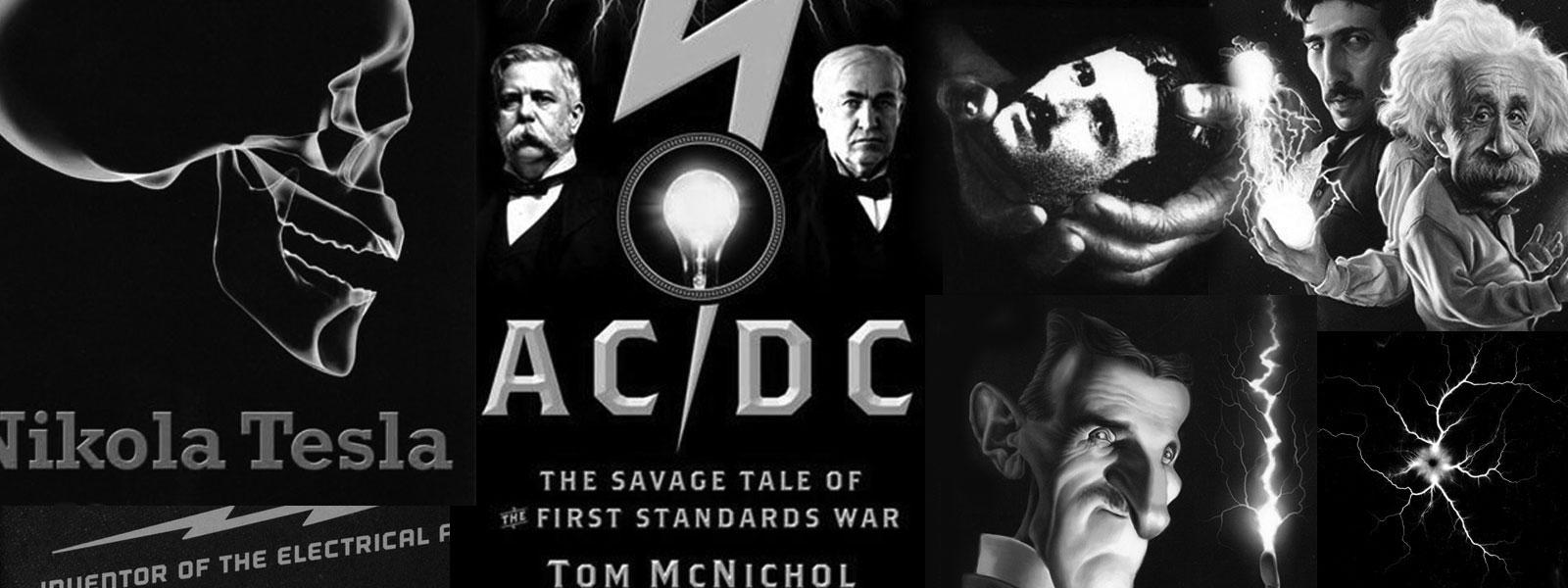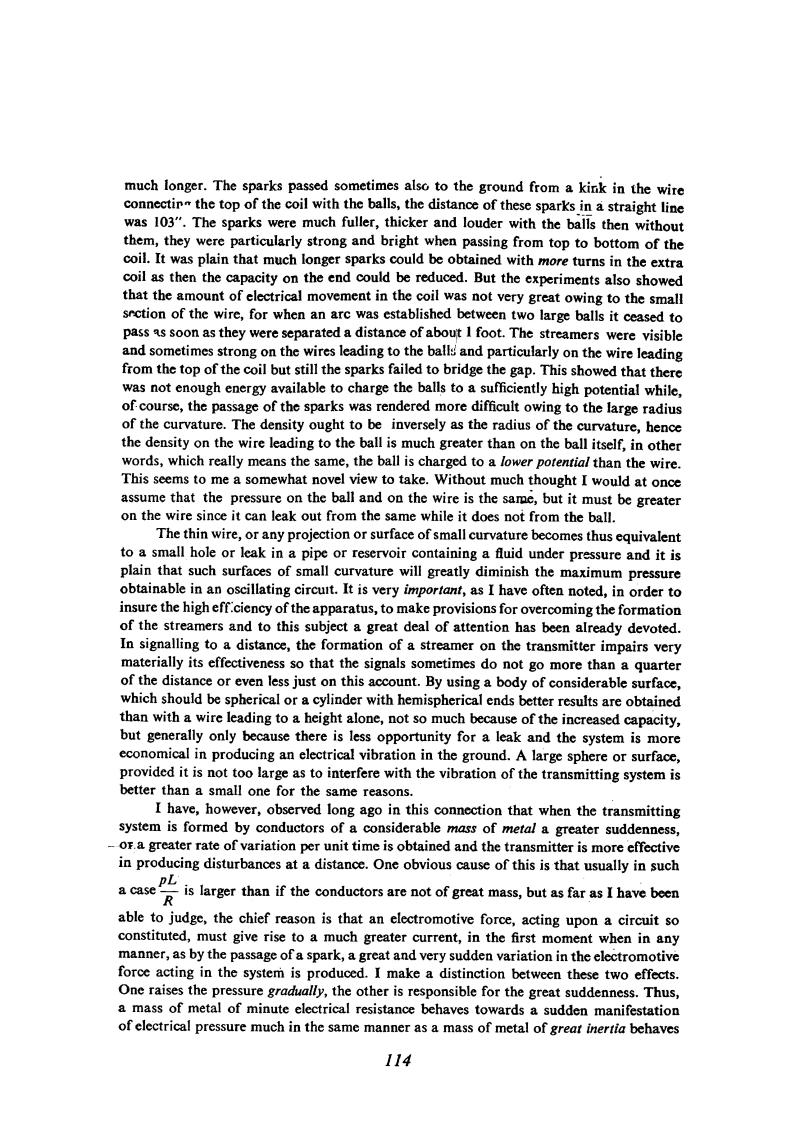
Nikola Tesla Books
much longer. The sparks passed sometimes also to the ground from a kink in the wire connecting the top of the coil with the balls, the distance of these sparks in a straight line was 103". The sparks were much fuller, thicker and louder with the balls then without them, they were particularly strong and bright when passing from top to bottom of the coil. It was plain that much longer sparks could be obtained with more turns in the extra coil as then the capacity on the end could be reduced. But the experiments also showed that the amount of electrical movement in the coil was not very great owing to the small section of the wire, for when an arc was established between two large balls it ceased to pass as soon as they were separated a distance of about 1 foot. The streamers were visible and sometimes strong on the wires leading to the balls and particularly on the wire leading from the top of the coil but still the sparks failed to bridge the gap. This showed that there was not enough energy available to charge the balls to a sufficiently high potential while, of course, the passage of the sparks was rendered more difficult owing to the large radius of the curvature. The density ought to be inversely as the radius of the curvature, hence the density on the wire leading to the ball is much greater than on the ball itself, in other words, which really means the same, the ball is charged to a lower potential than the wire. This seems to me a somewhat novel view to take. Without much thought I would at once assume that the pressure on the ball and on the wire is the same, but it must be greater on the wire since it can leak out from the same while it does not from the ball.
The thin wire, or any projection or surface of small curvature becomes thus equivalent to a small hole or leak in a pipe or reservoir containing a fluid under pressure and it is plain that such surfaces of small curvature will greatly diminish the maximum pressure obtainable in an oscillating circuit. It is very important, as I have often noted, in order to insure the high efficiency of the apparatus, to make provisions for overcoming the formation of the streamers and to this subject a great deal of attention has been already devoted. In signalling to a distance, the formation of a streamer on the transmitter impairs very materially its effectiveness so that the signals sometimes do not go more than a quarter of the distance or even less just on this account. By using a body of considerable surface, which should be spherical or a cylinder with hemispherical ends better results are obtained than with a wire leading to a height alone, not so much because of the increased capacity, but generally only because there is less opportunity for a leak and the system is more economical in producing an electrical vibration in the ground. A large sphere or surface, provided it is not too large as to interfere with the vibration of the transmitting system is better than a small one for the same reasons.
I have, however, observed long ago in this connection that when the transmitting system is formed by conductors of a considerable mass of metal a greater suddenness, of a greater rate of variation per unit time is obtained and the transmitter is more effective in producing disturbances at a distance. One obvious cause of this is that usually in such a case $! {pL \over R} $! is larger than if the conductors are not of great mass, but as far as I have been able to judge, the chief reason is that an electromotive force, acting upon a circuit so constituted, must give rise to a much greater current, in the first moment when in any manner, as by the passage of a spark, a great and very sudden variation in the electromotive force acting in the system is produced. I make a distinction between these two effects. One raises the pressure gradually, the other is responsible for the great suddenness. Thus, a mass of metal of minute electrical resistance behaves towards a sudden manifestation of electrical pressure much in the same manner as a mass of metal of great inertia behaves
114
July 30
To try and verify his hypothesis about the rejection of harmonics with appropriate coils, Tesla changed the connection of his âextra coilâ as shown in Figs. 4 and 5. To understand his way of proceeding one must take into account his ideas from 1893(6) concerning the induction of earth currents via an aerial-earth system. However, the standing waves in terms of which he tried to explain the arcing over the lightning arresters cannot be significant at these frequencies.
July 30
Along with the application of new "additional coil" Tesla repeats the experiments with his oscillator and after the usual matching procedure he achieves better results than in previous cases. He obtains sparks of approximately 2.5 meters in length. He considers the conductor curve radius influence on the current streamers appearance phenomenon. On this occasion he emphasizes the importance of current streamers elimination which create the losses and reduce the system efficiency for wireless transmission.
The conclusion on current streamers is correct, but that could not be said for the explanation of the advantage of having an elevated wire with capacitive loading in relation to the same wire without loading. In consideration of transitional events in oscillator circuits, he again separates the coil validity factor influence from the excitation influence (sudden current changes) at the instance of spark appearance and interruption in an oscillator arcing device.
Commenting on the non-existence of sparks on lightning arresters, he makes the judgment that the reasons for this are the high harmonics blocked by corresponding coils and they do not react to ground. In an effort to check his assumption, he changes "additional coil" connecting method according to Figure 4 and obtains a new oscillator configuration. Unfortunately, the experiment description is not complete, and it is not known whether he made some changes in the primary circuit in order to achieve, with connections in Fig. 3, 4, the maximum oscillator effect. The difference between connections in Figs. 4, 5 is that in the first the grounded sphere is excited via "additional coil", and in the second only the grounded sphere is excited. It is possible that the sphere system without additional coil oscillates at a higher frequency, but one cannot draw reliable conclusions without a deeper analysis.
The same day he devoted some time to design and calculation of a high frequency transformer for a high receiver. He intended to use it for operation with a "fast vibrating" system (probably as the one in Fig. 5). As far as design is concerned, the receiver was probably similar to the one of July 28.
As during many previous days, Tesla, this time as well, studies several problems. He found the time to study also the variation of voltage on supply transformer primary at various capacitive loadings. He found the voltage variation that points to the transformer impedance increase, although the secondary reactive impedance was being reduced.

